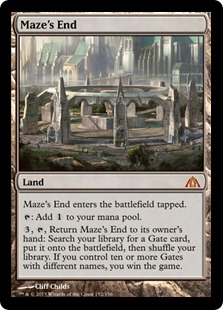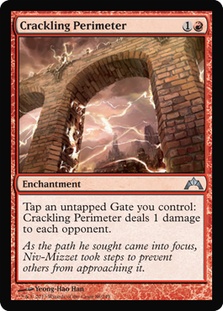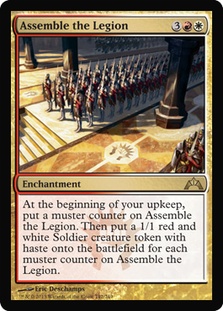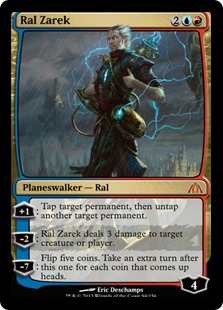Hello! As you may have gleaned from the title, I’ve decided to take a little sidestep from my usual area today and omit fresh tier 1 decks in the favor of a casual one.
Why Maze’s End?
Maze’s End is an interesting card that reads "you win the game"—it’s attractive, especially since having a win condition hidden in a land helps you have more slots for spells (as proven by Nephalia Drownyard). It’s hard to win the final match of PTQ with a million Maze’s End activations, but a 4-0 at FNM is very achievable; moreover, playing an underpowered deck offers many opportunities to improve your play.
I played Valakut, the Molten Pinnacle months before Primeval Titan was printed; drawing your Valakut naturally or finding it via Expedition Map was hard and took a long time, but it was interesting and made me disciplined. Maze’s End is somewhat similar, so I decided to look at its applications in Standard, especially as some decks have actually appeared. Block Constructed at the Pro Tour showed off two them: classic control and Turbo Fog; a recent SCG IQ in Tennessee highlighted the third version: a control build featuring miracles as a better Fog effects.
The classic control version is similar to other control decks but with more fragile mana. Two possible ways to build the deck are to make it U/W-centric or Grixis-centric. The first approach relies on the well-known combination of Sphinx’s Revelation and Supreme Verdict; the problem is that Supreme Verdict is extremely bad in a world of Thundermaw Hellkite, Falkenrath Aristocrat, and Voice of Resurgence. The U/W-centric version has a lot of suboptimal early removal, which is crucial for the early game and even more so with our mana.
Red offers much more here, including Pillar of Flame, so it’s better to build red-based control. Moreover, a Maze’s End shell allows you to mitigate one of Grixis’ major disadvantages; we could still splash for one or two copies of Sphinx’s Revelation to provide the necessary card advantage, which normal Grixis achieves by casting Far // Away into Snapcaster and using the -2 on with Jace, Architect of Thought. The place to start is with Kenny Oberg (and other Swedes’) list from the Pro Tour.
Creatures (4)
Lands (28)
Spells (28)

The natural changes are to the mana base, Elixir of Immortality, Pillar of Flame instead of Mugging, and Snapcaster Mage. Thragtusk may or may not make the cut; I won’t post the Standard-adapted decklist right here since there are some things I want to talk about before, so if you have two minutes, you should write down something like 33 of 34 spells and eventually compare them with my approach.
The second shell for Maze’s End is Turbo Fog. The deck is well known and is a fine metagame call for some situations—and it needs an alternative win condition to actually end game after multiple Fogs. Maze’s End may not be the fastest possible way to do so, but it’s a win condition that doesn’t cost you nonland slots and doesn’t force you to cut necessary Fog effects. Moreover, Maze’s End allows splashing good off-color cards if needed.
Creatures (7)
Lands (27)
Spells (26)
- 4 Fog
- 4 Think Twice
- 4 Safe Passage
- 1 Terminus
- 4 Supreme Verdict
- 2 Druid's Deliverance
- 3 Urban Evolution
- 4 Riot Control
Sideboard

This deck first inspired me to write this article when I saw it in Magic Online. Things I want to change here are the mana base and Terminus. Dirks even runs a playset of Think Twice and still has only one Terminus and four mediocre Supreme Verdicts—I simply don’t understand this decision. Two Sphinx’s Revelations would be fine here too since I don’t think that Riot Control is enough life gain and Urban Evolution is enough card draw. Augur of Bolas helps, but a 1/3 isn’t really relevant in Standard right now, so Snapcaster Mage should probably replace the poor Merfolk.
A little aside: one of the very probable reasons for Dirks’ card choices is the price. The whole deck costs fewer than $100 at SCG, which makes it very attractive for FNM. However, if you own some format staples or are willing to buy them (shocklands are always a good investment), you can easily make this list much better.
The third list for today is the one used by Tyler Bennett to make Top 8 of an SCG IQ in Tennessee.
Creatures (15)
Lands (26)
Spells (19)
- 3 Fog
- 4 Farseek
- 1 Elixir of Immortality
- 4 Terminus
- 3 Devastation Tide
- 1 Cyclonic Rift
- 3 Sphinx's Revelation
Sideboard

Here you see only ten Guildgates, seven miracles, and fifteen creatures. That’s an interesting take on Turbo Fog since it uses only three actual Fog effects (I could imagine having a little bit more). The most interesting part of the list in an interaction between Devastation Tide and life gain creatures. Assuming you cast Devastation Tide for its miracle cost, you’ll be able to recast one of your creatures on the same turn and another one on the next one. It’s an interesting substitute for Snapcaster Mage into Riot Control, isn’t it?
This sword (or shield) is obviously double-edged: both Terminus and Devastation Tide are sorceries, which means that you’re vulnerable to the hasty creatures that are some of the best aggressive threats of the format. Another edge that Terminus and creatures are way more effective Fog effects than Fog itself and you risk less than classic Turbo Fog. This deck typically operates at slightly higher life totals, and sweepers prevent it from being devastated by bad topdecks allowing opponent to finally connect with their entire team.
Which of these approaches is the best? Honestly, none of them is great, but they’re all playable, so it’s better to choose the one that is the most interesting. There are some similarities among these decks—like fine matchups against midrange decks (which actually makes Maze’s End not so bad right now) and weakness to red-based aggro (everything is not so bad, but more on this topic later). Let’s look at some general things about the Maze’s End shell before building decklists.
The first important point is the number of Guildgates. One may run ten of them, twenty, or any number between. Running only ten Gates becomes a problem if one of them is destroyed or exiled, but it’s better in other cases since you have much more space for casting your spells on time. Untapped Shocklands and basics could be crucial for surviving, and you’re not restricted to having two or three primary colors instead of an equable mana base. Ten Guildgates allow casting early spells consistently, with Gatecreeper Vine and Farseek or Pillar of Flame and Mizzium Mortars among possible important combinations.
The downside of ten Guildgates is a lesser chance to have enough of them in play by the time you draw Maze’s End. That makes cards like Urban Evolution worse and forces you to survive about two turns more before winning. However, the increased chances of surviving in early game may easily be worth it. You could play fourteen or fifteen Guildgates spread among your primary colors. You’re able to fear Acidic Slime less, have better Urban Evolutions, and still play untapped lands early for the cost of being forced to search for less optimal Gates with Gatecreeper Vine from time to time. Another major upside of having more than ten Guildgates is the ability to use Saruli Gatekeepers and Crackling Perimeter consistently.
The Swedish team that played Maze’s End at the Block Constructed Pro Tour mentioned Nightveil Specter as an important reason to play two of each Gate, but it doesn’t see Standard play, while problems with milling or discarding your lands are solved with Elixir of Immortality (unavailable in Block). Same as Block, Standard doesn’t include a lot of land destruction aside from Acidic Slime, but honestly the problem with Slime from Junk Reanimator is not the lack of the tenth Guildgate to win—it’s the simple shortness of mana. Moreover, having two of each Guildgate doesn’t save you from Acidic Slime, so an alternative win condition for this matchup is needed anyway, which probably eliminates the last reason to play twenty Guildgates.
Summing up the previous paragraphs, it’s likely right to play either ten or fourteen Guildgates in a Maze’s End deck in current Standard depending on the particular features of build. If you have a restricted budget, you could try a green-heavy version with Gatecreeper Vine. Nevertheless, I don’t expect borrowing shockland singletons to be a major problem.
The second point is alternative win conditions. It’s important to have one due to the necessity of faster ways to win more than to dodge dedicated hate. The whole concept of the deck is based on the presumption that our primary win condition is hard to disrupt, so the correct way of thinking about alternatives is not to back up the primary one but to use something that mitigates the Guildgates’ most important problem: they’re very slow. That’s why Door to Nothingness is unlikely to be very good here—it isn’t really faster than the primary win condition and has similar mana requirements.
Crackling Perimeter is not only what we need in case of problems with the last few Guildgates but also a perfect way to deal with opposing planeswalkers, which appear to be a problem for the deck not interacting with opponent. An early Crackling Perimeter could easily steal a game against control by itself. Midrange’s rise and the return of control decks mean that Perimeter could be a fine maindeck choice, and it’s more often an actual win condition than Maze’s End—similar to the beatdown plan more often being a win condition than comboing in Modern with Melira Pod.
Another enchantment to consider is the almighty Assemble the Legion; some decks just can’t beat it. Assemble also doubles as a sort of Fog effect and workable creature-based way to win for Turbo Fog deck, which normally operates in a mode where the opponent has many more creatures and useless removal. Assemble isn’t worth splashing into the existing Bant Turbo Fog deck, but nothing prevents it from being played in a five-colored deck. The last point about Assemble the Legion is that it isn’t affected by Pithing Needle, which is used against Aetherling by some decks and which could appear at your store if you start playing this deck.
Ral Zarek does a similar job to Crackling Perimeter in beating opposing planeswalkers and also helps the primary win condition. The main upside of Ral over Perimeter is its ability to deal with creatures, but disadvantages include a much higher vulnerability and a higher casting cost (which basically reads "much harder to resolve against control"), so the two-mana enchantment seems to be better for this deck. Jace, Architect of Thought is still fine for non-miracle decks, but there are chances of hitting two Guildgates with his mini-pact ability. It’s not the end of the world since we have Elixir of Immortality, but it may significantly slow the deck with only ten Guildgates, so it’s correct to avoid him too.
Another disadvantage of planeswalkers for the new miracles deck is that Devastation Tide resets our planeswalkers (even if it’s fine against opposing ones). That’s why Tyler Bennett correctly decided to omit walkers in the favor of creatures with life gain and enters-the-battlefield abilities; a miracled Tide becomes really Devastating when you recast Saruli Gatekeepers or even Centaur Healer afterward. Tyler runs only eleven Guildgates, so the full four Gatekeepers seems odd to me. I’d rather play four Centaur Healers because 3/3 is enough to trade with most of the aggressive creatures and trading is better than blocking with 2/4s all day.
Aetherling is an interesting choice because it’s nearly unstoppable, but it requires a lot of mana, which is hard to achieve even for a deck with a ton of unconditional tapped lands. That’s more crucial in comparison with the two-mana Crackling Perimeter, so the mighty Shapeshifter is unlikely to be good here. However, there are other creatures. The miracle version of the deck includes a ton of creatures—all defensive—but only Gatecreeper Vine actually has defender, so it’s possible to deal enough damage through attacks, especially with a little help from Kessig Wolf Run (if it fits into the 75, which isn’t clear to me).
On to the lists! I don’t think that mine are optimal, so suggestions and constructive criticism are appreciated.
Creatures (6)
Lands (27)
Spells (27)

The deck’s core didn’t change much; it just uses better cards to achieve the same goal. Notable changes include the cutting of Urban Evolution, which isn’t as good as it looks —I definitely don’t want to see multiples. The sideboarded Slaughter Games are mostly for Acidic Slime (assuming that you deal with mana dorks before). Notable omissions include Rapid Hybridization, which is an interesting and cheap way to deal with Sire of Insanity at instant speed (as is Selesnya Charm). However, you’ll likely see Rakdos’s Return right now, so Witchbane Orb it is.
Creatures (8)
Planeswalkers (2)
Lands (26)
Spells (24)
- 4 Fog
- 4 Safe Passage
- 1 Elixir of Immortality
- 3 Terminus
- 2 Supreme Verdict
- 3 Sphinx's Revelation
- 2 Urban Evolution
- 1 Crackling Perimeter
- 4 Riot Control
Sideboard

Snapcaster Mage by himself doubles the deck’s cost, but he’s worth running. The deck has some problems with aggressive red strategies (very popular on Magic Online right now), but it has some weapons to fight through endless small armies and Skullcrack (don’t forget to side in Dispel). Untapped lands, despite shocking ourselves, are very good in this matchup since every mana is crucial (missed land drops is usually the reason you lose to aggro). I’m also not sure about the exact combination of Fog effects; the deck has almost no early life gain, so Clinging Mists may work with fateful hour a significant amount of time.
Creatures (14)
Lands (26)
Spells (20)

I cut some Saruli Gatekeepers due to the small number of Gates in the list. Rapid Hybridization is a very nice instant way to deal with Sire of Insanity, Thundermaw Hellkite, etc. Selesnya Charm and Warleader’s Helix support it post-board (the second also comes in for matchups where additional life gain is needed).
That’s all for today. May your will be strong enough to give these brews a chance at your local FNM, and good look to everyone planning to attend SCG Open Series: Philadelphia!




